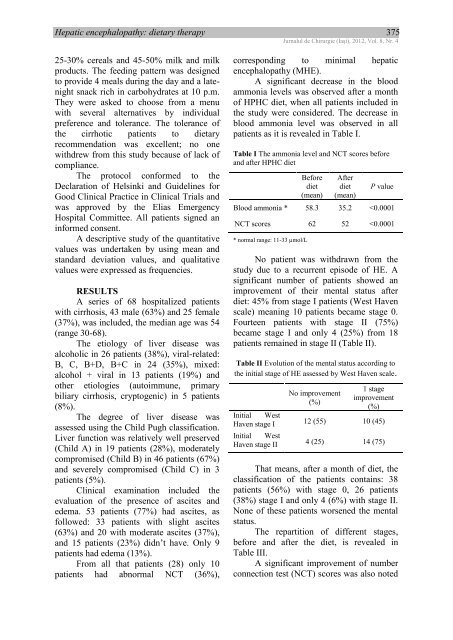PDF (5 MB) - Jurnalul de Chirurgie
PDF (5 MB) - Jurnalul de Chirurgie
PDF (5 MB) - Jurnalul de Chirurgie
Create successful ePaper yourself
Turn your PDF publications into a flip-book with our unique Google optimized e-Paper software.
Hepatic encephalopathy: dietary therapy 375<strong>Jurnalul</strong> <strong>de</strong> <strong>Chirurgie</strong> (Iaşi), 2012, Vol. 8, Nr. 425-30% cereals and 45-50% milk and milkproducts. The feeding pattern was <strong>de</strong>signedto provi<strong>de</strong> 4 meals during the day and a latenightsnack rich in carbohydrates at 10 p.m.They were asked to choose from a menuwith several alternatives by individualpreference and tolerance. The tolerance ofthe cirrhotic patients to dietaryrecommendation was excellent; no onewithdrew from this study because of lack ofcompliance.The protocol conformed to theDeclaration of Helsinki and Gui<strong>de</strong>lines forGood Clinical Practice in Clinical Trials andwas approved by the Elias EmergencyHospital Committee. All patients signed aninformed consent.A <strong>de</strong>scriptive study of the quantitativevalues was un<strong>de</strong>rtaken by using mean andstandard <strong>de</strong>viation values, and qualitativevalues were expressed as frequencies.RESULTSA series of 68 hospitalized patientswith cirrhosis, 43 male (63%) and 25 female(37%), was inclu<strong>de</strong>d, the median age was 54(range 30-68).The etiology of liver disease wasalcoholic in 26 patients (38%), viral-related:B, C, B+D, B+C in 24 (35%), mixed:alcohol + viral in 13 patients (19%) andother etiologies (autoimmune, primarybiliary cirrhosis, cryptogenic) in 5 patients(8%).The <strong>de</strong>gree of liver disease wasassessed using the Child Pugh classification.Liver function was relatively well preserved(Child A) in 19 patients (28%), mo<strong>de</strong>ratelycompromised (Child B) in 46 patients (67%)and severely compromised (Child C) in 3patients (5%).Clinical examination inclu<strong>de</strong>d theevaluation of the presence of ascites an<strong>de</strong><strong>de</strong>ma. 53 patients (77%) had ascites, asfollowed: 33 patients with slight ascites(63%) and 20 with mo<strong>de</strong>rate ascites (37%),and 15 patients (23%) didn’t have. Only 9patients had e<strong>de</strong>ma (13%).From all that patients (28) only 10patients had abnormal NCT (36%),corresponding to minimal hepaticencephalopathy (MHE).A significant <strong>de</strong>crease in the bloodammonia levels was observed after a monthof HPHC diet, when all patients inclu<strong>de</strong>d inthe study were consi<strong>de</strong>red. The <strong>de</strong>crease inblood ammonia level was observed in allpatients as it is revealed in Table I.Table I The ammonia level and NCT scores beforeand after HPHC dietBeforediet(mean)Afterdiet(mean)P valueBlood ammonia * 58.3 35.2
















